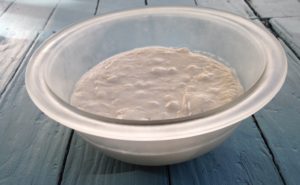I’ve been reading a really nice little book called Do Sourdough by Andrew Whitley—I’ll post more on that shortly. The book revived a question I’ve long had.
In making yeasted bread with commercial baker’s yeast, the yeast performs (aerobic) respiration and (anaerobic) fermentation. The results are the carbon dioxide and water that make the bread rise and the organic molecules that provide flavor. Respiration turns glucose into CO2 and water (plus energy is released), whereas fermentation results in a little CO2 and ethanol.
 I’ve read that, in sourdough starters, the wild yeasts are responsible for raising the dough, while the bacteria create the flavor. This never made sense to me: Don’t both kinds of microorganism perform fermentation and respiration? What’s the difference? This time, I started poking around looking for answers.
I’ve read that, in sourdough starters, the wild yeasts are responsible for raising the dough, while the bacteria create the flavor. This never made sense to me: Don’t both kinds of microorganism perform fermentation and respiration? What’s the difference? This time, I started poking around looking for answers.
My first thought was a dead end. I recalled that the wild yeasts and bacteria are symbiotic because they process different sugar molecules; maybe this resulted in the different outputs, I thought. But when I found the paper [1], it was the bacteria that were fermenting maltose (via glucose), the familiar reaction I described above. The yeast ferment the small percent of other sugars. I also wondered about different microorganisms producing different organic molecules, but this doesn’t change the production of CO2.
Finally I thought about the two processes at work. Maybe the situation is this [speculation alert!]: The yeast perform respiration, making the dough rise. (Eventually they might switch to fermentation when oxygen runs low, but maybe this is considered negligible in sourdough, or maybe the roles listed for each microorganism are not strict.) The bacteria DON’T perform respiration; they only perform fermentation, producing less CO2 (again, an amount that can be overlooked) and most of the flavor molecules.
Hunting online seemed to confirm this: Eukaryotes (like yeast) perform aerobic cellular respiration until the oxygen runs out. Some prokaryotic bacteria perform cellular respiration (aerobic OR anaerobic!), but some only perform fermentation. Lactic acid bacteria (LAB)? “They generally are non respiratory and lack catalase. They ferment glucose primarily to lactic acid, or to lactic acid, CO2 and ethanol. All LAB grow anaerobically, but unlike most anaerobes, they grow in the presence of O2 as ‘aerotolerant anaerobes.’” [2]
I’d like to have an “official” reference for this information, but yeast-related info (in my experience) is difficult to pinpoint. It’s too low level for a journal article, but microbiology textbooks are vague, plus there are so many different yeasts and bacteria out there. What I need is a paper on sourdough bacteria and how they function. Anyone seen one?
A neat consequence of this splitting of roles is pointed out in Mr. Whitley’s book: if you want to add more tang to your sourdough, decrease the amount of starter. Reducing the yeast population slows the dough’s rising, giving the lactic acid bacteria more time to work. For a milder dough, use more starter.
Note from author: This is the first blog post I’ve done in awhile. I’ve been spending my time finishing up my next book (a memoir) and building a freelance copyediting business, so I haven’t had the time to research the ideas I get for the blog. (This one isn’t really researched, as noted above!) I wanted to explain my long absence, which might continue for awhile.
[1] Sugihara, T.F., L. Kline, and M. W. Miller. “Microorganisms of the San Francisco sour dough bread process, I. and II.” Applied Microbiology 21 (1971) 456–458, 459–465.
[2] Todar, K. “Lactic Acid Bacteria.” Todar’s Online Textbook of Bacteriology. http://textbookofbacteriology.net/lactics.html [Accessed June 17, 2016].

Pingback: Do Sourdough | Food Chem Blog
Have you seen Debra Wink’s articles on The Fresh Loaf site?
Hi Dean, Thank you for pointing out these articles to me. I look forward to reading them.